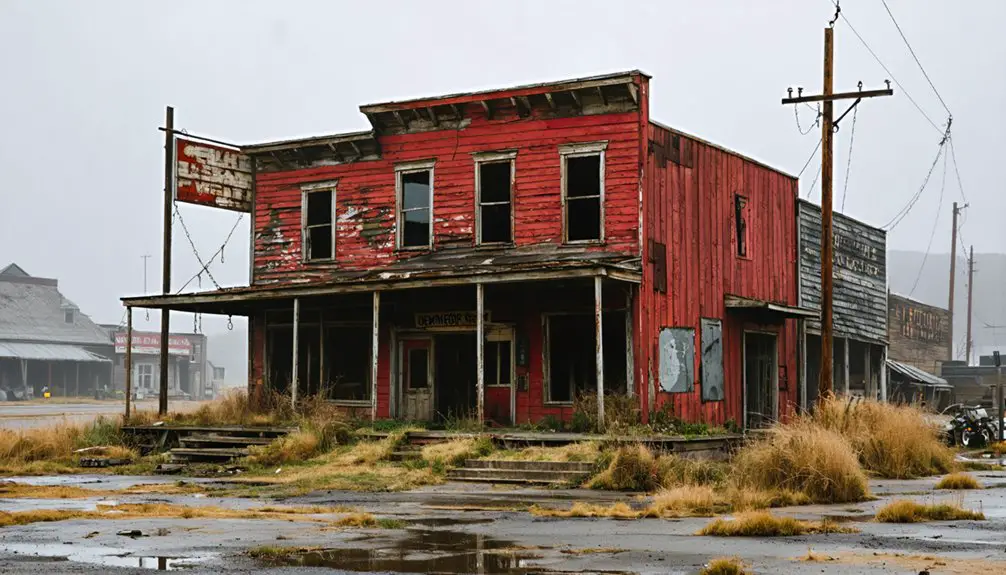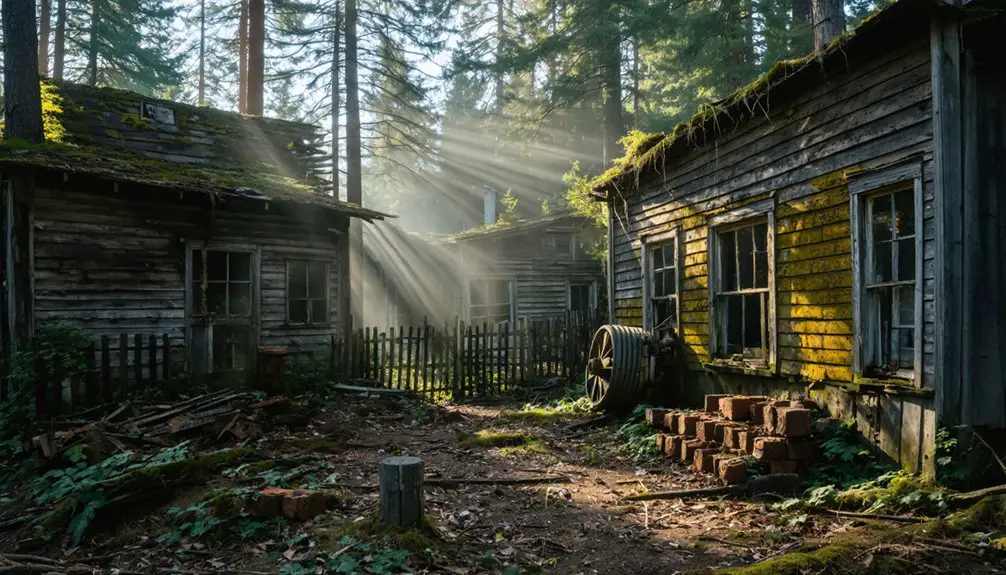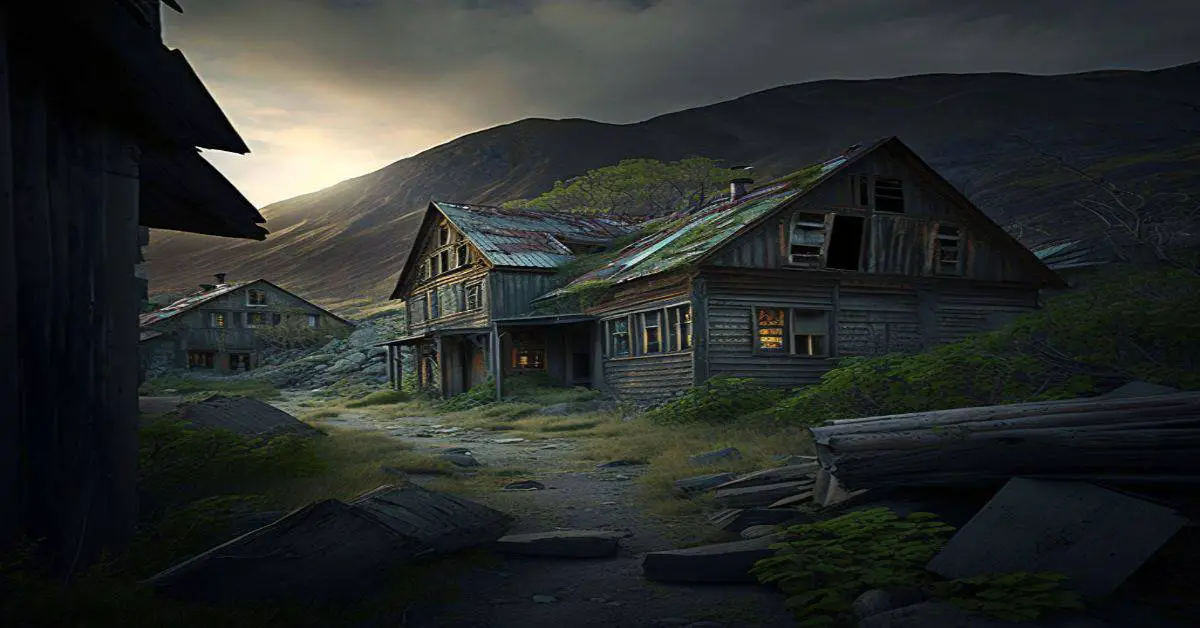You’ll find the lost Finnish settlement of Finn Town along Lake Michigan’s eastern shore, where immigrants established a thriving fishing community in the 1860s. The close-knit village centered around a dance hall and featured wooden homes, fish shanties, and ice houses. While the last structure, a red fish shanty, vanished in 1950, stone foundations and relocated buildings preserve the legacy of this once-vibrant cultural hub. The full story of Finn Town reveals a remarkable tale of resilience and transformation.
Key Takeaways
- Finn Town was a Finnish immigrant settlement in Michigan’s Upper Peninsula established in the 1860s for mining, fishing, and farming communities.
- The community centered around a dance hall and labor halls, which served as churches, schools, and social gathering spaces.
- Economic decline, driven by decreasing fish populations and evolving fishing technology, led to Finn Town’s abandonment by mid-20th century.
- The last visible structure, a red fish shanty, stood until 1950, with only foundations now blending into beach sand.
- Cultural heritage was preserved through building relocation and material salvage, with structures repurposed along West Loomis Street.
The Rise of a Finnish Fishing Settlement
While Michigan’s Upper Peninsula attracted Finnish immigrants primarily for mining work in the 1860s, these newcomers quickly established thriving communities across the region.
You’d find Finnish traditions deeply woven into these settlements, which expanded beyond mining towns into areas suited for fishing and farming. By 1880, over 1,500 Finns had settled in Keweenaw and Houghton counties, bringing their traditional fishing techniques and establishing cooperative systems that would shape local commerce. Many Swedish-speaking Finns joined existing Swedish settlements in the area. Following the push for Russification in 1899, thousands more Finns migrated to Michigan’s Upper Peninsula.
These determined settlers founded towns with familiar names like Nisula, Tapiola, and Paavola, creating cultural hubs where Finnish halls and churches became centers of community life.
The population continued to grow impressively, reaching about 75,000 by 1930, as Finns built strong social networks through temperance societies, cooperative stores, and local organizations.
Life on “The Island”
You’d find daily life in Finn Town centered around the tight-knit Finnish community, where families lived in close quarters along the narrow strip of beach between Lake Michigan and Pere Marquette Lake.
The dance hall served as the heart of the settlement, where Finnish cultural traditions and language flourished despite the physical isolation of their peninsula home. Herman Borg provided lively fiddle music for the community’s gatherings. Like their fellow Finns in Detroit who founded the Finnish Co-operative Summer Camp in 1925, the community worked hard to preserve their cultural heritage.
Survival required constant vigilance against Lake Michigan’s dangers and economic adaptability, as fishermen worked the waters in summer months before shifting to logging camps when winter ice choked the fishing channels.
Daily Finnish Community Life
Along the pristine white sand beaches between Pere Marquette Lake and Lake Michigan, Finnish settlers established a close-knit community marked by simple wooden homes, fish shanties, and ice houses.
You’d find these Swede-Finns maintaining their cultural identity through language, customs, and traditional fishing practices brought from their homeland.
Life revolved around the seasons, with fishing dominating the warmer months as residents hauled nets by hand from small sailboats.
When winter’s ice blocked the waterways, many shifted to logging camp work.
The community’s dance hall became the heart of cultural festivals and communal gatherings, where Finnish traditions flourished.
Despite pressures from lumber interests, the residents’ strong sense of solidarity helped them maintain their way of life through informal squatter’s rights, preserving their unique cultural enclave on Michigan’s shore.
Lake Dangers and Survival
Despite its pristine appearance, Lake Michigan posed deadly challenges for Finn Town’s residents, with dangerous currents and sudden weather changes threatening their survival on “The Island.”
The lake’s eastern shore, where the Finnish community settled, accounted for nearly half of all Great Lakes drowning deaths since 2010, averaging 12 fatalities and 23 rescues annually. Rip currents and strong waves made the shoreline particularly hazardous for residents. In 2024 alone, Lake Michigan drownings reached 51 deaths.
As a Finn Town resident, you’d face treacherous conditions requiring constant vigilance. The area’s isolation meant limited emergency response, while short wave periods and rapidly shifting winds created lethal swimming conditions.
Lake safety became paramount to survival, with the community relying on local knowledge and preparedness for drowning prevention.
- You’re on your own – no lifeguards patrolled these remote shores
- The lake’s deceptive currents could trap even strong swimmers
- Your survival depended on understanding the lake’s deadly moods
Cultural Heritage and Community Bonds
You’ll find Finnish musical heritage deeply woven into Finn Town’s social fabric, where workers gathered in halls to perform traditional folk songs and dances after long days in the mills.
The Finnish Workers Society’s hall, built in Detroit in 1923, became a central venue for these musical gatherings while also serving as a hub for labor organizing and cultural preservation.
John Matson’s violin brought life to the Saturday night dances that were a highlight of community entertainment.
As populations shifted, many of these community buildings found new purposes, with dance halls becoming residences and social spaces being repurposed, though their architectural significance continues to tell the story of Finnish immigrant life in Michigan.
Like nearby Jennings, which had Victorian-era houses still standing after the town’s decline, these structures serve as reminders of Michigan’s immigrant communities and their enduring architectural legacy.
Strong Finnish Music Traditions
Through the vibrant efforts of Michigan’s Finnish-American community, traditional Finnish music has remained a cornerstone of cultural identity in the Upper Peninsula’s Copper Country.
You’ll find this musical heritage thriving through institutions like the Finnish American Folk School and the Finnish Center Association, which organize camps, workshops, and performances. With a robust core membership base of over 500 people, these organizations ensure Finnish musical traditions remain strong and accessible.
The traditional kantele’s melodies still echo at festivals, weddings, and cultural gatherings, while folk dance music continues to unite communities. The Finnish Folk Music Camp, held annually at Finlandia University, helps preserve these cherished musical traditions.
- Witness generations of Finnish miners’ descendants keeping their ancestral tunes alive through annual folk music camps in Hancock
- Experience the soul-stirring sounds of traditional instruments at FCA events, where Finnish folk comes alive
- Join the celebration of cultural freedom through music at Vappu and Juhannus festivals, where tradition meets contemporary expression
Community Buildings Find Purpose
While Finnish immigrants settled into their new American lives, their community buildings became crucial anchors of cultural identity and social cohesion in Finn Town.
You’ll find the architectural heritage of these structures reflected in John Kasurin’s thoughtful designs, which merged Finnish craftsmanship with American industrial practicality. The buildings’ multifunctional nature supported robust community engagement, as labor halls doubled as churches, schools, and social gathering spaces.
At the heart of Finn Town’s vibrancy, you’ll discover how these buildings fostered deep connections through dances, cultural celebrations, and union meetings.
The Finnish Workers Society Hall, built in 1923, exemplifies this versatility. Even the fish shanties and docks served dual purposes, supporting both economic survival and social bonding within the close-knit immigrant community.
Maritime Challenges and Daily Life
The harsh maritime environment of Finn Town presented unique challenges for its Finnish settlers, who established their community on a peninsula between Lake Michigan and Pere Marquette Lake.
Nestled between two lakes, Finn Town’s pioneers carved out a home despite nature’s fierce resistance along Michigan’s unforgiving shores.
You’d find these resilient fishermen adapting their maritime techniques to survive, using small sailboats and manual fishing methods like gill nets. When winter ice blocked the channels, they’d shift to alternate work in logging camps, demonstrating their resourceful nature and determination for freedom.
- Your home would’ve stood on white sand beaches, where you’d build fish shanties and ice houses despite the unstable terrain.
- You’d have to master handling small boats in Lake Michigan’s tough weather while hauling heavy nets by hand.
- During winter’s grip, you’d join your neighbors at the dance hall, maintaining community bonds when fishing wasn’t possible.
Economic Decline and Abandonment

Maritime life in Finn Town encountered devastating economic pressures by the mid-20th century, leading to its ultimate abandonment.
You’ll find that the town’s economic sustainability hinged almost entirely on lake fishing and related maritime activities, making it vulnerable when fish populations declined and fishing technology evolved. As larger boats centralized operations elsewhere, the town’s economic foundation crumbled.
The lack of economic diversification and infrastructure investment severely impacted community resilience.
You can trace how younger residents were forced to seek opportunities in urban centers like Ludington, while aging infrastructure and dwindling tax revenues further accelerated the decline.
Physical Remnants and Artistic Legacy
Standing until 1950, a weather-beaten red fish shanty marked Finn Town’s last visible structure, perched on a stone foundation near Lake Michigan’s shore.
Today, you’ll find only a crumbling foundation blending into beach sand, though remnants exploration reveals traces of this once-thriving Finnish community.
Weathered stones sink slowly into timeless sands, whispering stories of Finnish fishermen who once called these shores home.
The site’s artistic expressions flourished as painters captured the shanty against white dunes and lake waters, preserving Finn Town’s maritime heritage through their works.
- Discover fishermen’s footprints near the harbor breakwater, following the same paths where their predecessors once hauled in their daily catch
- Experience the haunting contrast between natural landscape and the ghostly stone foundation, telling tales of lives lived and left behind
- Feel the artistic pulse of a vanished community through paintings that immortalize its spirit against Lake Michigan’s eternal horizon
Preservation Through Repurposed Materials
After Finn Town’s abandonment, resourceful Finnish-Americans preserved their community’s legacy by relocating entire structures and salvaging building materials to the Ludington mainland.
You’ll find evidence of this material reclamation in homes along West Loomis Street, where lumber from multiple Island dwellings was combined to construct new residences.
The town’s dance hall exemplifies this adaptive reuse, transforming from a cultural hub into a temperance society meeting place before becoming a private home.
This practice of building reuse guaranteed cultural continuity as Finnish families maintained tangible connections to their original settlement.
Through community-driven salvage efforts, they embedded their heritage into Ludington’s architectural landscape.
Stone foundations remain on The Island as silent markers, while repurposed materials continue telling Finn Town’s story through mainland structures that stand today.
Historical Significance in Michigan’s Finnish Communities
While Michigan’s Upper Peninsula drew Finnish immigrants to its copper mines after the Civil War, the state’s cultural landscape transformed dramatically as Finnish settlements expanded across both peninsulas.
By 1930, you’d find nearly 75,000 Finns and their descendants in Michigan, establishing distinct settlement patterns through towns like Nisula, Tapiola, and Paavola. The preservation of Finnish identity flourished through churches, lodges, and cooperative stores that anchored these communities.
- You can still trace the legacy of Finnish determination in places like Finn Town, where seasonal workers balanced fishing and logging to build thriving communities.
- The establishment of temperance societies and cooperative stores reflects their commitment to collective well-being.
- Finnish cultural institutions in Ishpeming and Hancock became nationally recognized centers for preserving heritage.
Frequently Asked Questions
Were There Any Documented Shipwrecks or Drownings Near Finn Town?
You won’t find any documented shipwreck history or drowning incidents in local records, despite the area’s Great Lakes location. Early residents’ extreme caution and careful maritime practices helped prevent such tragedies.
What Specific Fish Species Did the Finn Town Fishermen Primarily Catch?
Like a GPS tracking fish, you’d find Finn Town’s commercial fishermen primarily caught whitefish and lake trout using gill nets, while also landing perch and bass from Great Lakes waters.
Did Any Native American Settlements Exist at This Location Before Finn Town?
While Native Americans likely used the coastal area seasonally, you won’t find definitive evidence of permanent settlements at this specific peninsula before Finn Town, though Anishinaabe peoples inhabited the broader region.
How Did Residents Receive Mail and Essential Supplies on the Isolated Peninsula?
You’d receive mail and supplies primarily by boat, with scheduled mail delivery stops along the shoreline. Supply routes connected you to regional hubs like Ludington, bringing essential goods across Lake Michigan.
Were There Any Schools or Churches Established Within Finn Town?
You won’t find documented schools or churches within Finn Town’s boundaries. Residents likely sent their children to mainland schools and attended religious services in Ludington for their education and spiritual needs.
References
- https://www.swedishfinnhistoricalsociety.org/2020/10/11/finn-town/
- https://www.nailhed.com/2017/10/the-ghost-town-that-moved.html
- https://www.swedishfinnhistoricalsociety.org/2020/10/11/living-on-the-island/
- https://exploringthenorth.com/ghost/towns.html
- https://www.nailhed.com/2017/10/
- https://finlandabroad.fi/web/usa/finns-in-michigan
- https://guides.loc.gov/finns-in-america/chronology
- https://en.wikipedia.org/wiki/Finnish_Americans
- https://www.nailhed.com/2017/10/detroits-finnish-hall-and-battle-of.html
- https://ethnicity.lib.mtu.edu/groups_Finns.html


